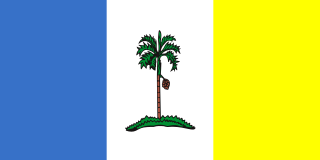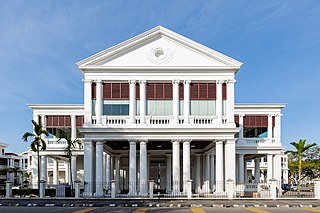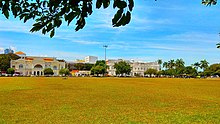
George Town is the capital of the Malaysian state of Penang. It is the core city of the George Town Conurbation, Malaysia's second largest metropolitan area with a population of 2.84 million and the second largest metropolitan economy in the country. The city proper spans an area of 306 km2 (118 sq mi) encompassing Penang Island and surrounding islets, and had a population of 794,313 as of 2020.

The Tun Abdul Razak Complex is a civic complex of five buildings within the central business district of George Town, Penang. It first opened on 2 December 1976. At the time of its completion in 1985, the central skyscraper of the complex, Komtar Tower, at 231.7 metres (760 ft), was the tallest skyscraper in Southeast Asia. The complex contains 1,420,000 square feet (132,000 m2) of office and retail space on a 27-acre (11 ha) superblock. It is a major bus terminal for Rapid Penang, and the seat of the Penang state government and the chief minister of Penang.
The Chingay Parade is an annual street parade held in Malaysia and Singapore as part of the Chinese New Year festivities, usually in celebration of the birthdays of Chinese deities or in some cases with the procession of the Goddess of Mercy (Guanyin). The name "Chingay" derives from Hokkien, conflating two words: chin-gē (真藝) meaning "true art", and chng-gē (妝藝) meaning "art of costume". PAYM has been an active contributor to Chingay in Singapore. Today, the parade is celebrated by all communities of both Malaysia and Singapore.

Seberang Perai is a city in the Malaysian state of Penang. Located on the Malay Peninsula and separated from Penang Island by the Penang Strait, it shares borders with Kedah to the north and east and Perak to the south. The city spans an area of 748 km2 (289 sq mi) and had a population of 946,092 as of 2020, making it the third largest city in Malaysia.

The State of Penang, one of the most developed and urbanised Malaysian states, is located at the nation's northwest coast along the Malacca Strait. Unlike most Malaysian states, the history of modern Penang was shaped by British colonialism, beginning with the acquisition of Penang Island from the Sultanate of Kedah by the British East India Company in 1786. Developed into a free port, the city state was subsequently governed as part of the Straits Settlements, together with Singapore and Malacca; the state capital, George Town, briefly became the capital of this political entity between 1826 and 1832. By the end of the 19th century, George Town prospered and became one of the major entrepôts in Southeast Asia.

Edwardian architecture usually means a Neo-Baroque architectural style that was popular for public buildings in the British Empire during the Edwardian era (1901–1910). Architecture up to 1914 is commonly included in this style.
The Penang Island City Council is the local government that administers the city of George Town, which includes the entirety of Penang Island. The city council, which has jurisdiction over an area of 306 km2 (118 sq mi), falls under the purview of the Penang state government.
John Buttery was a merchant operating in the Straits Settlements of Penang, Malacca and Singapore. He was, at the time of his death, the senior partner of Sandilands, Buttery & Co., and John Buttery & Co..
Cheah Tek Soon was a 19th-century Penang businessman, and headman of the Hokkien in Penang, after whom Tek Soon Street was named. He was an active member of the Penang community and the bandstand that was erected near the Town Hall before the Japanese Occupation was his gift to the city.

Robert Ibbetson was a colonial governor of the Straits Settlements of Penang, Malacca, and Singapore from 1832 to 1834.

The flag of Penang consists of three vertical bands and an areca-nut palm on a grassy mount in the centre. All three bands are of equal width. From left to right, the colour of each band is light blue, white and yellow.
The Queen Victoria Memorial in George Town, Penang is a monument to Queen Victoria, begun after her death, located at the Penang Chinese Recreation Club. Penang's Victoria Memorial takes the form of a large piece of land known as "Victoria Green," and a statue at the edge of Victoria Green at the junction of Burmah Road and Pangkor Road, the establishment of each being years apart from the other. The grounds were purchased and set up in 1903 and the statue unveiled in 1930, nearly three decades later.

Robert Norman Bland (1859–1948), or "R. N. Bland," as he was more commonly known then in The Straits, was Resident Councillor of Penang and a career civil servant in the Colonial Administration of the Straits Settlements.

The Cenotaph is a war memorial in George Town within the Malaysian state of Penang. Constructed in 1929, the memorial commemorates Allied servicemen who lost their lives during World War I. Located at the city's Esplanade, it serves as a venue for Remembrance Day ceremonies.

The Penang High Court, founded in 1808, is the birthplace of Malaysia's judiciary system. It is housed inside a Palladian-style building at Light Street, George Town, Penang. To this day, the High Court sits at the top of Penang's hierarchy of courts.

Light Street is the oldest road in the city of George Town within the Malaysian state of Penang. It was named after the founder of Penang, Captain Francis Light. As the epicentre of George Town, the street was created soon after Light established the settlement in 1786 and has been serving as a major thoroughfare within the city centre ever since.

The Town Hall is a British-built administrative building in George Town, Penang, Malaysia. It is located adjacent to the City Hall, which now serves as the seat of the Penang Island City Council.

George Town, the capital city of the state of Penang, is the second largest city in Malaysia and the economic centre of the country's northern region. The history of George Town began with its establishment by Captain Francis Light of the British East India Company in 1786. Founded as a free port, George Town became the first British settlement in Southeast Asia and prospered in the 19th century as one of the vital British entrepôts within the region. It briefly became the capital of the Straits Settlements, a British crown colony which also consisted of Singapore and Malacca.

The Tuanku Syed Putra Building is an office building in George Town within the Malaysian state of Penang. Completed in 1962, the building, situated at Downing Street within the city's Central Business District (CBD), is owned by the Malaysian federal government and accommodates the Penang General Post Office (GPO). It once served as the seat of the Penang state government and, until 1966, was the tallest building in George Town.

The Penang Islamic Department Building is an office building in George Town within the Malaysian state of Penang. Completed in 1909, the building, situated at Downing Street within the city's Central Business District (CBD), was formerly part of the Government Offices, the administrative seat of Penang under the Straits Settlements. It now accommodates the Penang Islamic Department.



















